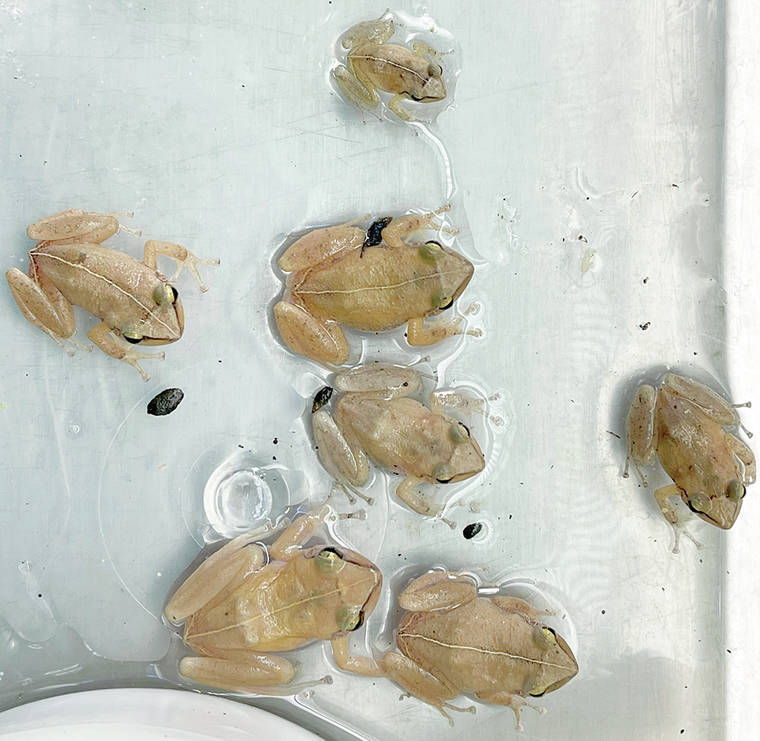LIHU‘E — State officials are working to get a handle on a coqui frog infestation in a remote area on O‘ahu, and while Kaua‘i was declared coqui-free in 2012, the tiny frogs still crop up once in a while on the island.
They travel between islands as hitchhikers in nursery plants or in vehicles, which is why invasive-species experts advise people receiving shipments from other islands to thoroughly inspect arrivals for the frogs.
In Waimanalo on O‘ahu, a multi-agency eradication effort is currently in full swing, including the state Department of Land and Natural Resources, Hawai‘i Invasive Species Council, O‘ahu Invasive Species Committee and state Department of Hawaiian Home Lands.
The primary area impacted appears to be about an acre along the base of the mountains in Waimanalo, where 65 coqui frogs have been hand captured so far.
“Unfortunately, this coqui infestation is in a remote area, and has gone undetected for some time despite HDOA staff responding to reports and conducting night monitoring for more than 10 years in Waimanalo,” said Phyllis Shimabukuro-Geiser, chairperson of the state Board of Agriculture.
“We appreciate the assistance of our partner agencies in this effort to contain and eradicate this coqui population, and we continue to urge residents to report any suspected coqui infestations.”
In early February 2021, a resident reported hearing coqui frogs in the area, but no frogs were heard or captured that night by DOA Plant Quarantine Branch inspectors, according to a DOA release about the incident.
Inspectors returned to the area five times since that report, and were able to capture one to three coqui frogs each time, and were then able to hear some coquis in the distance. The inspectors worked to get approval to search surrounding properties that were under the jurisdiction of the Honolulu Board of Water Supply, DLNR and DHHL.
On March 30, a team of six state inspectors searched the area, were able to pinpoint the area of infestation and were able to capture 33 coqui frogs. Another team of inspectors subsequently conducted a survey on Friday evening, April 9, to further determine the extent of the infestation. An additional 18 coqui frogs were captured that night.
On April 14, a crew from PQB, DLNR and OISC conducted a daytime survey to map out the terrain, which helped to determine the best strategy to contain and eradicate the infestation.
The survey allowed the team to comprehensively assess the area and surrounding vegetation, providing them a baseline to begin the process of coordinating resources to conduct habitat modification.
The survey also indicated that traditional means of getting treatment equipment into the area would not be feasible, primarily due to the terrain. Alternative options were discussed.
The next day, a team of five PQB inspectors captured an additional 14 frogs, conducted some limited habitat modification efforts and additional surveys in areas immediately adjacent to the infestation. The team did not discover any additional populations.
The DOA says the immediate concern is to prevent the frogs from spreading to other areas. PQB staff will be routinely conducting night searches to remove frogs from the area and ensure that the frogs are not spreading.
On O‘ahu in June 2003, a coqui infestation was detected in a nine-acre, forested area in Wahiawa, including part of the U.S. Army’s East Range.
A coordinated effort involving DOA, DLNR, OISC and the U.S. Army was successful in eradicating that population using citric-acid treatments. The last coqui was heard in November 2006, and surveys continued until August 2007, when DOA declared that the population was eradicated.
The total cost of the three-year effort was about $235,000.
On Kaua‘i, a breeding population was discovered in 2001 that covered about 10 acres in Lawa‘i. After an extensive eradication effort, Kaua‘i was declared coqui-free in 2012.
The small, nocturnal frogs have no natural predators, and have been known to decrease property values because of their loud, chirping noises.
•••
Jessica Else, editor, can be reached at 245-0457 or jelse@thegardenisland.com.


